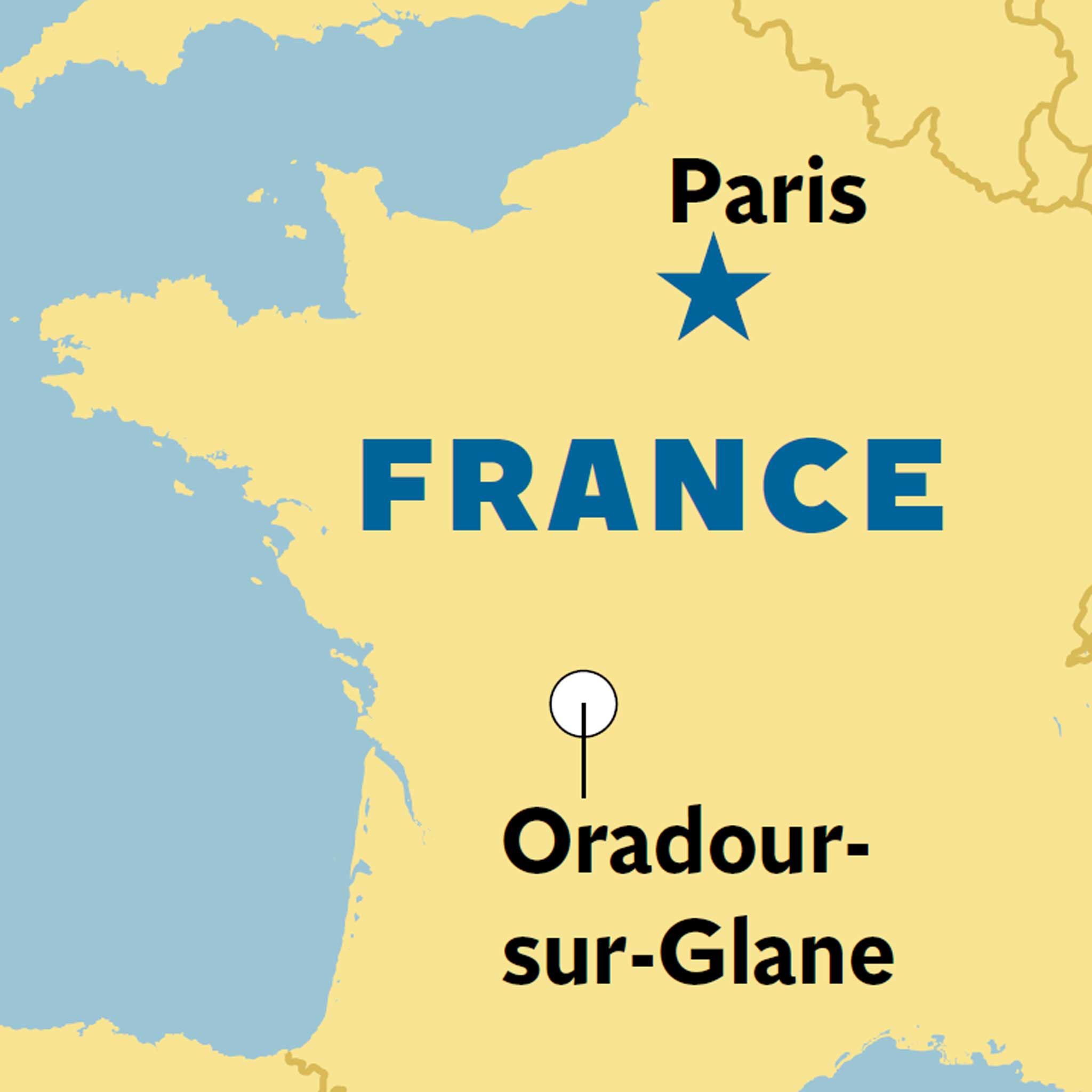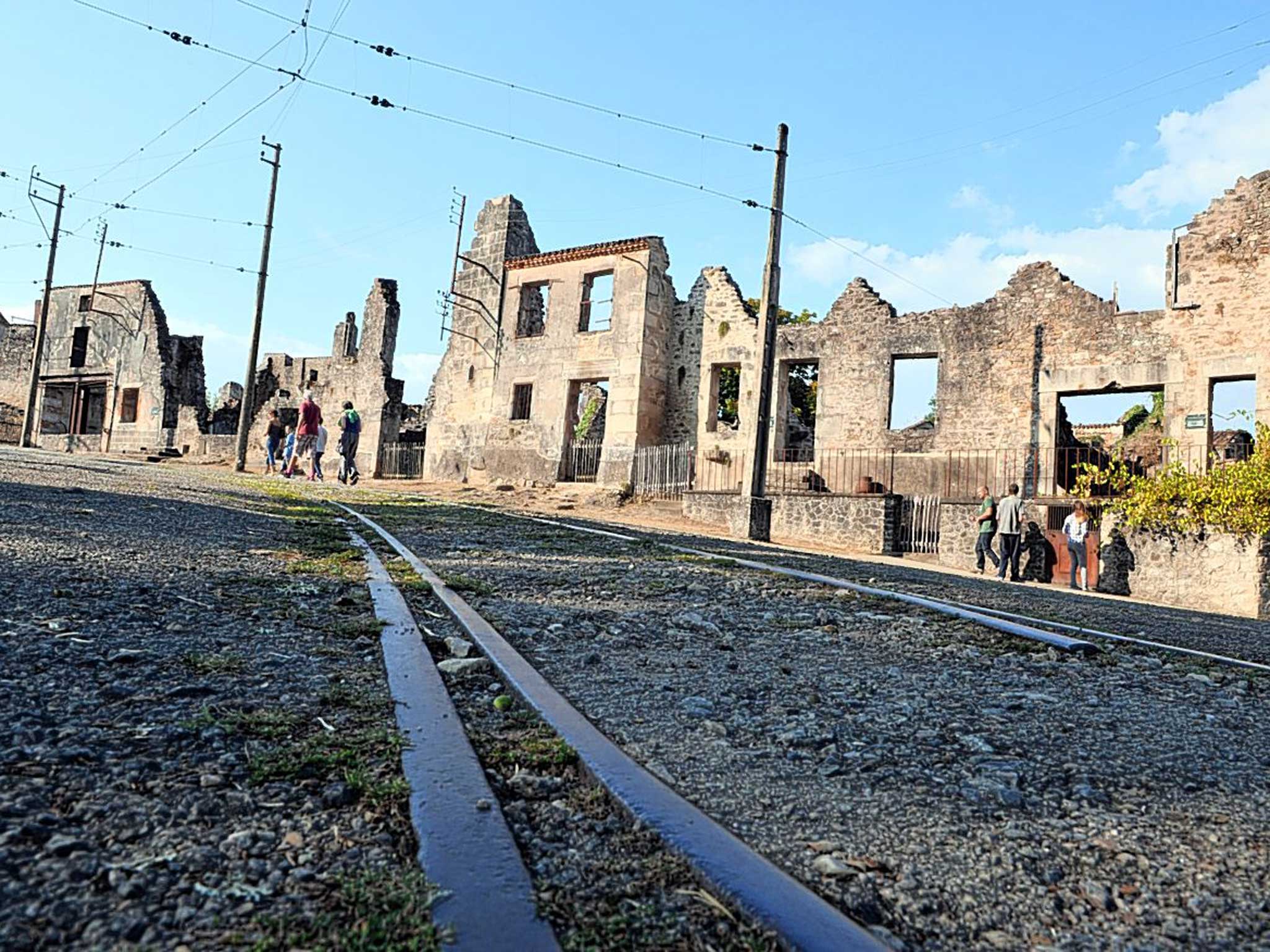A few years ago, in a forest on the borderland of Poland and Belarus, my guide stopped suddenly in a clearing. "Listen to that," he said. I listened. "Birds never sing here," he said. "In 1943, local villagers who would not betray the whereabouts of the partisans to the Nazis were brought here and shot." A barbed wire wreath on a stump of oak was the only sign. That, and the eerie silence.
I remembered this as I drove through the rolling hills of the Haute-Vienne in central France on my way to Oradour-sur-Glane. I had read about Oradour in a poem by Tom Pow in a book devoted to the dead and dying villages of Europe; Oradour's tale was by far the darkest, a wartime tragedy that stalked my imagination.
Peach groves and cattle stippled the countryside as I reached the village hinterland. I could see ahead on my right, above a canopy of low trees, the crisp crenellation of blackened walls – and beyond them a tower that might be a church that had lost its steeple.
Along this route, direct from Limoges, on 10 June 1944, came the 2nd Company of the SS "Der Führer" regiment. They arrived in a convoy of lorries and armoured cars on a sunny afternoon, disgorging soldiers dressed for combat.

What happened next is described in unflinching detail in the permanent exhibition at the Centre of Remembrance for Oradour, which contextualises the events of 10 and 11 June. The centre, hidden under trees, penetrates the hillside, and its front is barely visible. It tells how Oradour, during five years of European conflagration, had been a hub of rural tranquillity, taking no part in the French resistance. Along one side of a long, narrow gallery is charted the rise of Nazism, the outbreak of the Second World War and the creation of the supine French Vichy government, which collaborated with Hitler.
Along the opposite wall runs a timeline of Oradour life throughout the same period, illustrating – in black-and-white photographs, on cine film, in documents – the idyll of a village sublimely contented: children playing outside the school, the village baker serving customers, people relaxing, enjoying a picnic beside the glassy River Glane. It's a parade of pure innocence made more poignant by what happened on the day those stories collided.
Around two o'clock that afternoon the troops blocked exits from the village. People were hounded from their homes and school children were herded with their teachers into the square (a special medical inspection had been in progress at the school). A single child evaded capture. Roger Godfrin, an eight-year-old refugee from Lorraine who had seen the Nazis in ruthless action, hid in a garden while the population of Oradour was corralled on the village green. The women and children were led away and then locked in the church.
Two hours later, the men were divided into groups and forced under guard into separate barns on the edge of the village. Minutes later, they faced firing squads. Some died instantly, others were wounded, then finished off.
Inside the locked church, the women had heard the distant salvo of machine-guns. Some feared the worst, others wondered if they would be spared – after all, they considered the church a sanctuary. An explosion answered their question. A cloud of smoke, then acrid fumes, caused screams and panic. The Nazis entered, firing methodically into the maelstrom until there was silence.
Remarkably, the Germans recorded much of this on film. Scraps of footage are shown at the end of the exhibition, together with painful reminders of loss. A display of salvaged and charred possessions – shoes, mangled spectacles, kitchen implements – serve to personalise the tragedy.
What the Germans could not record were those who escaped. Five of the men, by feigning death, had watched the soldiers torch the village. Then they crawled into the trees under cover of darkness. Only one woman survived. Madame Rouffanche, whose daughters and grandson died by her side in the church, climbed through a window and fell to freedom. In all, 642 people had been exterminated, the village reduced to rubble.
With these images inescapable, you exit the exhibition by climbing a ramp towards the open sky. Along with others, I stood at the top and looked around at what makes this experience unique.
Here, in all its burnt horror, the village itself has been preserved and lays before us. In March 1945, the Free French leader General de Gaulle declared: "Oradour-sur-Glane is a symbol of the calamities of the country. The memory must be kept alive…"
And so it has been. No one spoke. We walked through the streets in silent slow-motion. Some people took photographs, others just stared – at the roofless buildings, the now-rusting tram tracks cluttered with weeds, the battered hulks of ancient motor cars, now rusted and burnished like modern works of art.
Inside the church, I counted bullet holes; then I stopped. Outside, above doorways were painted the faded ghosts of shop signs. Through gaping windows, suggesting a life once lived, lay the remains of everyday domesticity: tangled bedsprings, a Singer sewing machine. I remembered Tom Pow's poem, entitled "Singer":
"In Oradour/when the killing was done, they looted all/they felt was of worth. The rest they condemned/to fire."
When I turned around to retrace my steps I saw in the distance a towering memorial and, beyond it, a second village, with a steeple-capped church, where every building was roofed – the second Oradour, completed in the image of its forebear in 1953.
In the Milord Café half an hour later, I ate lunch and talked with the waitress in faltering French about the importance of not forgetting. "It must not happen again," she nodded. Outside in the trees the sound of birdsong rose and fell. It filled me with hope.
Getting there
Limoges is served by Ryanair (0871 246 0000; ryanair.com) from Bristol, Leeds/Bradford and East Midlands; and Flybe (0871 700 2000; flybe.com) from Southampton. Eurostar (08432 186 186; eurostar.com) sells tickets from London via Paris to Limoges for around £139.
Staying there
The Mercure in Limoges (00 33 55 534 6530; mercure.com) has doubles from €90, room only.
Visiting there
Centre of Remembrance (00 33 5 55 430 430; www.oradour.org). Entrance: adults €7.80/children €5.20.

Join our commenting forum
Join thought-provoking conversations, follow other Independent readers and see their replies
0Comments